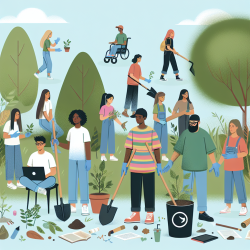The environment plays a crucial role in supporting youth participation, particularly for those with physical disabilities. The research article "Focusing on the Environment to Improve Youth Participation: Experiences and Perspectives of Occupational Therapists" provides valuable insights that can help practitioners enhance their skills by implementing environment-based interventions like the PREP (Pathways and Resources for Engagement and Participation) approach. Here, we summarize the key findings and offer practical steps for occupational therapists to improve youth participation.
Understanding the PREP Approach
The PREP approach is a client-centered, strength-based intervention aimed at improving youth participation in community-based activities by modifying environmental aspects. This 12-week program focuses on:
- Setting participation goals
- Identifying environmental barriers and facilitators
- Implementing solution-based strategies
- Measuring outcomes
- Ensuring sustainability
Key Findings from the Study
The study highlighted four main themes, two of which are particularly informative for practitioners:
1. Multi-Layered Composition of the Environment
Therapists identified various environmental barriers to participation, including:
- Physical barriers: Accessibility and availability of adapted equipment
- Social barriers: Family support and community attitudes
- Institutional barriers: Eligibility criteria for programs
- Attitudinal barriers: Parents' and community members' perceptions
2. Leveraging Resources and Problem-Solving
Therapists employed a range of strategies to overcome these barriers, such as:
- Searching for and sharing information about community programs
- Collaborating with various stakeholders, including other therapists, teachers, and community program directors
- Developing new resources and supports
Practical Steps for Practitioners
To implement the findings from this research, occupational therapists can:
- Adopt a holistic view of the environment, considering physical, social, and attitudinal factors.
- Engage in collaborative problem-solving with families and community stakeholders.
- Use coaching strategies to empower youth and their families to identify and overcome participation barriers.
- Focus on creating sustainable participation solutions by integrating interventions within the youth's natural environment.
Encouraging Further Research
While the PREP approach has shown significant improvements in youth participation, ongoing research is essential to refine these strategies and explore their application in different settings. Practitioners are encouraged to stay informed about the latest research and consider participating in studies that further investigate environment-based interventions.
Conclusion
By focusing on the environment and leveraging community resources, occupational therapists can significantly enhance youth participation in various activities. The PREP approach offers a practical framework for achieving these outcomes. For a more detailed understanding, we encourage practitioners to read the original research paper.
Focusing on the Environment to Improve Youth Participation: Experiences and Perspectives of Occupational Therapists 









